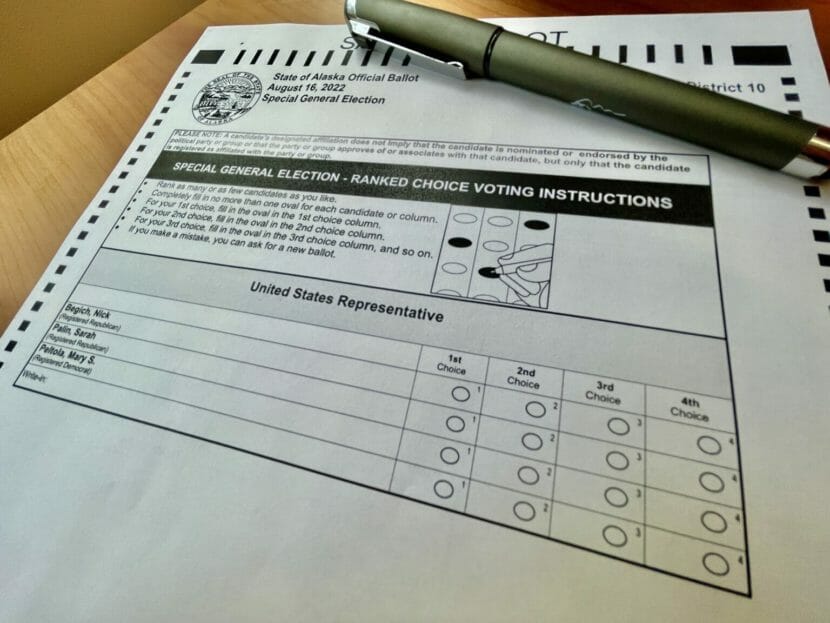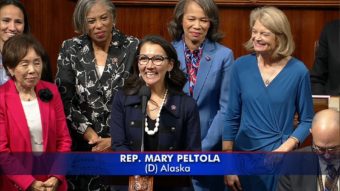
Ranked choice voting is new and different. Alaskans will have their first chance to do it Aug. 16, when we choose who will represent us in the U.S. House for the rest of the year.
Will your ballot count if you only select one candidate and don’t rank a second or third? What if you assign all the rankings to the same candidate?
Alaska Public Media reporter Liz Ruskin answered those questions and more on Alaska News Nightly.
Listen:
The following transcript has been edited for length and clarity.
Casey Grove: What if I don’t want to rank? Maybe I only like one candidate.
Liz Ruskin: You don’t have to rank. Your ballot will count if you just vote for one candidate as your No. 1. You can do that. But you shouldn’t.
Casey Grove: And why’s that?
Liz Ruskin: Because you won’t be fully exercising your power as a voter. It’s very unlikely that any of the statewide races will be decided by just the first-choice votes. We’re going to essentially have an instant run-off. As it turns out, we only have three candidates on Alaska’s first ranked choice ballot, so it’s easy to see how it works.
Say you and your neighbor both choose Candidate C as your No. 1, and she finishes last. She’s eliminated. If you did not rank any other candidates, you’ve had your say, and that’s as far as it went.
But what happens next is all the ballots that went to Candidate C are re-examined, to see if the voter indicated a second choice. If your neighbor ranked a No. 2 candidate, his ballot is added to that candidate’s pile. Your ballot goes nowhere. Your neighbor has effectively voted in the runoff election, and you sat that election out.
Casey Grove: But we hear from voters who, after their first choice, do not want to vote for either of the other two candidates in the special election. Some progressive voters say they’ll vote for Democrat Mary Peltola and they just cannot bring themselves to fill in any oval for the Republicans, Nick Begich or Sarah Palin, even if it’s for second or third place.
Liz Ruskin: It’s true among some Republican voters, too. Some Begich voters really have an aversion to Sarah Palin, and vice versa, and they can’t imagine voting for a Democrat. A friend of mine who is a naturalized citizen and I think recognizes the awesomeness of being able to vote put it this way: “Why should I put my name to any of the candidates I can’t stand?”
What I’d say is that ranking your choices in no way diminishes your vote for your favorite. All it does is say, if your favorite is no longer in the running, who else do you want, or who would be the least bad?
If you really have zero opinion on candidates beyond the first one – if you have absolutely no preference – then fine. Don’t rank. But study their positions. Maybe there is a difference between them on an issue that you care about.
UAA Associate Professor of Economics Kevin Berry applies game theory to ranked choice voting. He says even when the remaining candidates are diametrically opposed to you on all policy issues, it doesn’t cost you anything to fill in the rest of the ovals. You might still want to rank the remaining candidates based on other factors. Like who you think will be better at representing Alaska at important national events. Or who you think will be better at constituent services.
Berry says the new system presents voters with more difficult questions, and here’s how he put it:
Kevin Berry (recording): “In the past we just kind of said, ‘Who the candidates are is settled by a partisan primary,’ and then ‘What team am I on?’ and voted for that team,” he said. “Now, we need to think really hard about who these candidates are. And even amongst the people we disagree with, who would at least be the best at answering my phone call?”
Casey Grove: What about voters who are so passionate about their one candidate, they vote them as their No. 1, 2, and 3 pick? Maybe there’s a Sarah Palin super voter out there who votes for her three times. What does that do?
Liz Ruskin: That’s essentially the same as not ranking and just selecting a No. 1. If your favorite is eliminated, so is the rest of your ballot. There’s no point in doing that. But your ballot will be counted in the first round.
Casey Grove: What if I like two candidates equally and assign them the same ranking? Does that spoil my ballot?
Liz Ruskin: The Division of Elections considers that an overvote and will toss your ballot at the point at which the overvote occurs. So if you correctly vote for one candidate as your No. 1 and then two candidates as your No. 2, only your No. 1 will count. Once your favorite is eliminated, you have no other rankings that will count.
Casey Grove: What if I don’t like any of them? Does this ranked choice voting system still allow me to write in a candidate? And if so, does the write-in get ranked?
Liz Ruskin: Yes, you can write in a candidate and rank your write-in, but the Division of Elections will only count write-ins if, in aggregate, they finish first or a close second in the initial results.



